Northern and arctic societies. Рубрика в журнале - Arctic and North
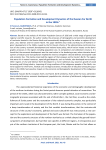
Population formation and development dynamics of the Russian Far North in the 1920s
Статья научная
Based on the analysis of All-Union Population Census of 1926 and a wide range of general and regional scientific research, the author studies the processes of demographic and economic development of territories located in the Russian North and conventionally designated by the author as regions of European, Ural, Siberian and Far Eastern North. The paper identifies key trends and features of Northern regions' development in the 1920s, caused by the first Soviet reforms of the administrative-territorial structure of the country, economic development and national state policy, which had an impact on the demographic processes in the regions including population size, its composition and settlement structure. It is found that the economic development was the most active in the bordering areas, where intensive development of industry and transportation implied the need to strengthen national defense and expand trade and economic ties. This mainly concerned the regions of the European and Far Eastern North. The regions that were rich in natural resources, especially gold deposits, such as Yakutia, also developed more actively. Other regions of Ural and Siberian North developed in a more traditional way, based on growth of wood harvesting and fishing industry. Improving of living conditions of the indigenous peoples of the North, material support for their farms, medical care and legal assistance, introduction of education among the population in the 1920s had a positive impact on the economic and demographic development of the indigenous population.
Бесплатно
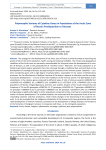
Population of the Komi Republic: From the 1897 Census to the 2021 Census
Статья научная
This article examines the population censuses conducted in the Russian Empire, the USSR and the new Russia; it reveals the peculiarities and methodological apparatus of each population census, presents the main questions of census lists, their comparability with previous censuses, notes new questions and explains their application. Thus, in the 2010 population census, the term “household” was introduced in the question on kinship (property) with other persons living with the respondent; in the question on marriage status, the concepts “officially divorced” and “separated” were differentiated; the levels of education and the presence of a degree were highlighted; the results of population censuses are given according to statistical data for the Komi Republic. The results of the population censuses of 1939 and 1959, which made it possible to assess the scale of forced migration to the Komi region, are separately considered. For each population census, the timing of its conduction and the critical moment are given, it is explained why certain population censuses were carried out not in the “zero” year, as is customary in most countries of the world, but in other years. Particular attention is paid to the 2021 census, it has been postponed for one year due to the COVID-19 pandemic.
Бесплатно
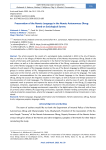
Preservation of the Nenets Language in the Nenets Autonomous Okrug: Based on Sociological Survey
Статья научная
The article presents the results of a sociological study conducted in 2022 in the city of Naryan-Mar, as well as in the villages of Nelmin Nos and Krasnoe of the Nenets Autonomous Okrug. Based on the results of interviews with specialists and experts in the field of the Nenets language, working in education and culture, as well as in the relevant executive authorities of the Okrug, conclusions about the preservation of the Nenets language in the region were made. Particular attention is paid to the respondents’ perceptions of such aspects of the language situation as the use of the Nenets language by different population groups in various spheres of life, intergenerational transmission, the presence of the language in public space and on the Internet, and the motivation of the population to learn and use the language. The study resulted in recommendations for the preservation of the Nenets language in the Nenets Autonomous Okrug, taking into account the linguistic situation in the region, as well as Russian and foreign practices for the preservation of small languages. The following are proposed as priority areas of work: (1) organizing systematic work to preserve and improve the status of the Nenets language in the Okrug; (2) supporting workplaces, initiatives, organizations and individuals involved in the preservation of language and culture; (3) creating an attractive language environment, especially in the digital sphere (the Internet), with a focus on primary school children; (4) supporting communities, especially reindeer herding communities and agricultural production cooperatives, where the language is used and its intergenerational transmission is maintained.
Бесплатно
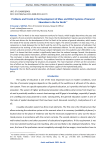
Статья научная
The Far North is the most important territory for Russia, which largely determines the pace and prospects of socio-economic development. This means that its development requires special attention. One of the main drivers for the development of the Far North is the system of general education, which meets the needs of the society and the economy of the macro region. The article considers it in two ways. First, a comparison is made between the Far North and the rest of the country of the dynamics of indicators that characterize the training of the most talented and motivated children. For this purpose, the number of winners and prize-winners of the all-Russian subject Olympiads since the academic year 2011/2012 is analyzed. It is shown that their number is significantly lower than the national average. Second, the dynamics of number of educational institutions, children attending them, and teachers working there are considered. The conclusion is made about the significant deterioration of the indicators, which is associated primarily with unfavorable demographic dynamics. The problems faced by the education system are considered and measures aimed at improving the situation are proposed. The most important of them are the concentration of efforts on the development of the mass system of general education, preparing children for work and living in rural areas, and improving the information support of the implemented policy.
Бесплатно
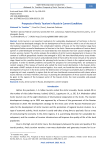
Prospects of Arctic Tourism in Russia in Current Conditions
Статья научная
Arctic tourism is an important mechanism for sustainable development of territories in the Far North. Russia has developed strategies for the development of Arctic tourism, which is one of the areas of international cooperation. However, the complicated relations of Russia on the international stage have endangered further successful development of tourism in the Arctic. Numerous problems of tourism development in underdeveloped territories are exacerbated by new obstacles that have caused changes in the tourism services market. The article analyzes the problems of Arctic tourism development in Russia in the context of a difficult geopolitical situation that emerged in 2022. We have identified priority issues hindering the development of Arctic tourism and predicted which of them will be the most relevant at the present stage. Based on this, possible directions for planning Arctic tourism in Russia in the regional context were proposed. In order to identify problems and justify the prospects for overcoming them, we conducted a content analysis of the reviews of tourists who visited the main tourist destinations in the Russian Arctic, and made a SWOT analysis of Arctic tourism logistics. As a result, we found that the main problem for the development of tourism in the Arctic will be the deterioration of transport accessibility due to difficulties in organizing air travel, especially in regions that do not have land-based communications with places where tourist interest is formed. Therefore, the focus in planning the development of Arctic tourism should now be given to the regions of the European sector of the Russian Arctic, the most accessible and popular among tourists.
Бесплатно
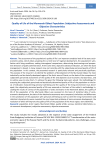
Статья научная
The assessment of the population's quality of life is an important analytical tool of the state socio-economic policy, which allows analyzing the current level of regional development, the population's satisfaction with living conditions, making interregional comparisons, determining shortcomings and prospective directions of public administration. At the same time, objective statistical indicators, on which the state management is based, in many respects may not coincide with the subjectively perceived quality of life of the population. In this context, the presented research is particularly relevant and practically significant. The purpose of the research is to identify the problems of development of the Murmansk Oblast, the most industrially and territorially developed region of the Arctic zone of Russia, on the basis of the comparison of subjectively perceived assessments of the quality of life and objective socio-economic characteristics, and to outline ways to solve them. To achieve this goal, the following tasks were solved: the methodology for assessing the subjectively perceived and statistically determined quality of life of the population on the basis of indicators characterizing personal well-being and the quality of the living environment was developed; the subjectively perceived quality of life was assessed on the basis of the author’s methodology including the results of surveys of the population of cities and towns in the Murmansk Oblast; the quality of life of the population of the Murmansk Oblast was assessed on the basis of statistical data of socio-economic development; the data of the obtained assessments were compared, similarities and differences in the satisfaction of the population with personal well-being (as well as with the living environment) and statistical characteristics were revealed; the most important problems of socio-economic development, the resolution of which will improve the quality of life of the population of the Arctic region, were identified.
Бесплатно
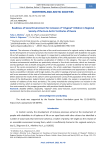
Статья научная
The relevance of studying the state of the social environment of a regional society is determined by the development of inclusive processes that involve the integration of people with disabilities into public life as full members of society. In this regard, it is important to understand the level of readiness of society to include disabled children due to the large-scale disability of the child population and the existing need to create special conditions for the positive socialization of children in this category. The issues of creating inclusive environmental conditions are particularly relevant in Euro-Arctic territories, which are characterized by significant risks to health and quality of life of the population. In order to identify the level of readiness of the social environment of regional society, the article undertakes theoretical and empirical research, including an analysis of the characteristics of the social environment and approaches to determining its accessibility in domestic and foreign studies, the author’s typology of private social environments, as well as an assessment of the state of infrastructural and socio-psychological barriers for children with disabilities based on the results of the author’s online questionnaire survey of the population of the Arctic territories of the Northwestern Federal District conducted in 2022 (n=861, the sample is proportional to the number of residents of the Arctic territories). The survey revealed the existing barriers to inclusion in the studied territories, which is important in the implementation of social policy measures to create a barrier-free environment for the younger generation with persistent health disorders.
Бесплатно
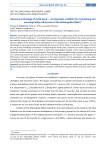
Статья научная
Ensuring the social security of the modern family is an urgent issue and a priority of the national policy of the Russian Federation. In contemporary society, the relationship between the social security system and the resource of the family is visible. Family resource acts as a set of potentials aimed at maintaining the stability of the family and the development of its competence in solving family problems. So, the technology of social work aimed at enhancing the resources of the family is essential. The same is fair for the role of the immediate environment in supporting the family since it becomes an active subject in solving family problems. Such an instrument is restoration technologies focused on the resource potential of the family and the resources of social capital. These technologies are widely used in foreign social work and are a promising area for the Russian one. The use of these technologies can be a factor in increasing the effectiveness of family institutional resources in the social protection of the population. Also, the author analyzed the role of recovery technologies in ensuring the social security of the family and examined the use of these technologies in the Arkhangelsk Oblast.
Бесплатно
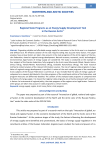
Regional State Programs as an Energy Supply Development Tool in the Russian Arctic
Статья научная
Organizing reliable and affordable energy supply for consumers in the Arctic area is an important and difficult task. An effective solution of this task requires taking into account many factors. This paper analyzes how various factors are taken into account in the state programs of the Arctic regions of the Russian Federation, aimed at regional energy development. Natural resource, economic, social, technological, environmental, legal factors of energy supply are considered. The study is conducted on the example of four subjects of the Russian Federation, fully assigned to the Arctic zone (Murmansk Oblast, Nenets Autonomous Okrug, Yamalo-Nenets Autonomous Okrug, Chukotka Autonomous Okrug). The main research method is content analysis of the relevant information sources. The role of regional state programs in regulation of regional energy development is specified. A review of the main state programs of the considered Arctic subjects of the Russian Federation is carried out. It was revealed that the tasks of energy supply development are unevenly distributed in the state programs of the constituent entities of the Federation, and program measures are differently detailed. The content of the analyzed state programs is compared with the factors of energy supply. It is shown that regional state programs are primarily compared with economic factors. As instruments of regional policy, the state programs of the regions act as legal factors. Factors of other groups are taken into account in state programs to a lesser extent.
Бесплатно
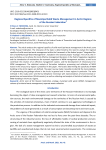
Regional specifics of municipal solid waste management in Arctic regions of the Russian Federation
Статья научная
The article analyzes the regional specifics of solid municipal waste management in the Arctic zone of the Russian Federation. The relevance of the topic is determined by the need to analyze the regional specifics of solid municipal waste management within the framework of the federal project "Integrated System of Solid Municipal Waste Management", included in the national project "Ecology". First of all, this request will allow us to achieve the most effective management decisions in the field of regulatory regulation and the introduction of mechanisms for economic regulation of MSW management activities, as well as to contribute the creation of an effective management system, and the development of infrastructure for MSW management. The statistical analysis of formation indicators, processing and utilization of MSW waste in the structure by region is presented in this paper. The factors determining the specificity of MSW handling in the Arctic regions are defined. The expert survey made it possible to identify the main problems of implementing the garbage reform in the Arctic in general and in inner regions in particular. The main methods in this study were: semi-formal telephone interviews with representatives of environmental organizations and associations (18 informants), as well as collecting and analysis of statistical indicators of the MSW handling in the Arctic regions.
Бесплатно
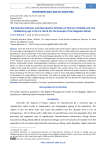
Статья научная
Since the end of the last century, the northern and north-eastern regions of Russia have entered the final stage of demographic transition, in which the birth rate has fallen below the replacement level of generations, and the proportion of the elderly population has increased to its historical maximum against the background of a mass outflow of the working-age population to the central regions of the country. The demographic transition in this territory is heterogeneous and has its own specifics related to the structure of the economy and the nature of employment, migration flows, the historically established settlement pattern, unfavorable climatic and geographical conditions, and patterns of reproductive and consumer behavior. In order to study this specificity, 226 women aged 25-44 were surveyed in Magadan Oblast. The subject of the study was women’s reproductive attitudes, their marital status, focus on having many children, few children or no children, identification of the expected, desired and actual number of children, factors leading to the refusal to have more children, as well as those stimulating childbearing, the problem of distribution of responsibilities in the family. The study has shown that family values are a priority for women of middle and late childbearing age, but they are associated with the demand for improved housing conditions and increased income.
Бесплатно
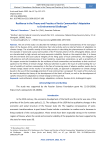
Resilience in the Theory and Practice of Arctic Communities’ Adaptation to Environmental Challenges
Статья научная
The aim of this study is to describe the individual and collective characteristics of the rural population of the Russian Arctic, which determine their vital activity and are internal factors of adaptation to climate change. The scientific novelty of the study consists in describing the phenomenon of resilience on the example of island and coastal communities of the Primorskiy district of the Arkhangelsk Oblast, which are characterized by high natural and socio-economic instability. Based on the empirical data, it is shown that the territorial and socio-cultural integrity of the living space of local communities, the integrality of self-existence and self-consciousness of local residents, cooperative coexistence, as well as proactivity of life support create the foundation for the resilience of local communities and contribute to their social adaptation to the effects of climate change. Particular attention is paid to the issue of understanding the culture of mobility of northern communities in the face of increasing cases of adverse weather events due to climate change. Based on the results of an empirical study, an approach to adaptation to climate change based on the use of the knowledge potential of local communities is proposed. The results of the study can be used to develop the theory of the development of the North of Russia, as well as the development of specific measures for adaptation to climate change at the local level.
Бесплатно
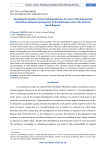
Статья научная
A lot has been said about the low quality of territory development programs at the regional and municipal levels in Russian literature. However, rare examples are given to confirm this thesis. In the case of such closely related issues as demographic and the education system development at the municipal level, we consider the territorial planning schemes and show these issues are not given sufficient attention. In terms of demography, the main disadvantages are an insufficiently detailed analysis of the age distribution of the population and its dynamics, analysis of a very short period (1-4 years), underestimation of existing trends (e.g., a wave-like change in the population), and an extremely weak demographic forecast. Concerning the education system, the main disadvantages are a short review horizon (1-3 years), insufficient analysis of trends and justification of the proposed measures, the use of planned rather than real indicators, which leads to an underestimation of demographic trends, insufficient analysis of the accessibility of educational organizations. A more detailed analysis of indicators over a greater number of years should be carried out to improve the quality of the schemes. When developing them, it is necessary to involve a specialist in demographic forecasting. Finally, it is required to create a model scheme that can be guided by developing schemes at the municipal level.
Бесплатно
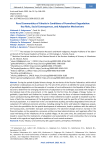
Статья научная
During the period of global climate change, the territories of the Russian Federation, within which permafrost is widespread, are at particular risk. The aim of this article is to identify the social consequences of permafrost degradation on the example of a number of rural settlements in the Republic of Sakha (Yakutia) and to determine the emerging mechanisms of adaptation to the challenges associated with changes in the habitual state of the environment. In this regard, for the first time, the villages of Amga, Yunkur, Argakhtakh, Lippe-Atakh and Ulakhan-An, located in Yakutia, were the focus of relevant interdisciplinary research conducted during 2019–2022. The work in these settlements made it possible to establish local features of both the consequences of the degradation of permafrost and the specifics of their perception by the local population. It is noted that in the rural settlements studied, permafrost degradation limits the development of traditional economic activities, including among the Arctic and Subarctic indigenous population, limits the possibilities for the spatial development of settlements, leads to problems with the safety of the housing stock, and hinders transport communication. The observed changes entail an increase in the financial burden on the population, economic entities and local administrations, and negatively affect the social well-being of the inhabitants of the studied villages. At the same time, the conducted research allowed to reveal that the mechanisms of adaptation and sustainability of rural communities that are being formed in this regard are largely based on traditions of rural mutual assistance.
Бесплатно
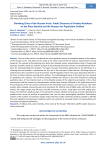
Статья научная
The aim of the article is to identify the most significant causes of population decline in the regions of the Russian Arctic. The object of this study is the urban communities of Vorkuta, represented in social networks. The concept of the declining city, which has received various interpretations both in foreign and domestic scientific literature, and the concept of place identity have been chosen as the theoretical framework for comprehending the problem. The paper presents theoretical approaches to the definition of a shrinking city and provides a justification for the use of the concept of place identity. Shrinking cities are understood as the cumulative result of economic and demographic factors that cause population decline in the form of natural decline and migration outflow. The methodological basis of the work was the method of qualitative text analysis. The narrative analysis method was chosen as the main method of analyzing qualitative data. At the empirical level, a more detailed analysis of the subjective perception of the urban environment and the reasons for the population outflow from Vorkuta, reflected in the public discourse of the participants of the city’s online community in the VKontakte social network, was carried out. The initial analysis base included community posts and comments for 2022 (a total of 9032 posts and 191733 comments), the target sample was 64 posts and 366 comments to them. Using open and axial coding techniques, the dominant subdiscourses in the perception of place identity and a group of urban development problems that cause the outflow of population from the city were meaningfully identified. Quantitative analysis of the number of comments (under posts) and likes (under comments) made it possible to identify the most significant and persistent problems, which are certainly of increased interest to representatives of municipal and regional authorities.
Бесплатно
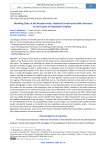
Статья научная
The purpose of the article is to determine the most significant causes of population decline in the regions of the Russian Arctic. The object of the study was the urban population of the subjects of the Russian Arctic. The concept of a shrinking city, which has received various interpretations both in foreign and domestic scientific thought, was chosen as a theoretical framework for understanding the problem. In this article, the shrinkage of cities is understood as a cumulative result of economic and demographic factors that cause population decline in the form of natural loss and migration outflow. On the basis of statistical data, a steady demographic decline was recorded in the cities of the subjects of the Russian Arctic. This made it possible to confirm the validity of the use of this concept in relation to these territories. Based on the materials of domestic and foreign studies, the most general, systemic factors of population decline in the regions of the Russian Arctic were identified, such as: the historical context and the policy of Soviet industrialization, the specifics of the local (regional) identity of the inhabitants of the northern territories, global demographic trends. At the empirical level, a more detailed analysis of the subjective perception of the reasons for the outflow of the population from the Murmansk Oblast, reflected in the public discourse of the participants of the online community of the city of Murmansk in the social network VKontakte, was carried out. The initial analysis base included posts and comments of the community for 2021-2022 (a total of 23.817 posts and 926.583 comments), the target sample included 268 posts and 2621 comments. Open and axial coding techniques were used to identify three groups of urban development issues as causes of the outflow of population from the region: 1) natural and climatic conditions, 2) quality of life, 3) prospects for the development of the city. Quantitative analysis of the number of comments (under posts) and likes (under comments) allowed us to identify the most significant and persistent problems, which, of course, are of increased interest to representatives of municipal and regional authorities.
Бесплатно
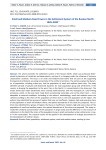
Small and Medium-Sized Towns in the Settlement System of the Russian North: 1939–2020
Статья научная
The article examines the settlement system of the Russian North, which was previously determined by decisions of ministries and departments, and now it is changing under the influence of resource corporations' activities. The focus is on small and medium-sized towns that are part of the supporting framework of settlement, ensuring connectivity of the northern territories. The authors analyze the dynamics of population, including urban one, and the population of small and medium-sized cities. The study identifies periods of upward and downward dynamics for each population group and settlements. If the country is drawing the population to the west, then in the North it is concentrated in the Asian part. The article shows that urban settlements were created multifunctional, with the monopoly of a city-forming enterprise, which, on the one hand, made them economically vulnerable, and on the other hand — more adaptable to external conditions. According to the author's methodology, small and medium towns are ranked according to the share of the population of these cities in the total population of the region. The authors have identified four groups of regions that have an insufficient, medium, high and excessive share of the population of small and medium towns; the optimal boundaries of this share are proposed. The authors have identified four groups of regions that have an insufficient, medium, high and excess share of the population of small and medium towns; the optimal boundaries of this share are proposed. The study revealed the similarity (concentration of the population in large cities) and the difference in the structure of settlements in the North (the share of the population living in small and medium urban settlements, is lower in the countryside). The research results will be applied in the development of strategic documents for the development of northern towns.
Бесплатно
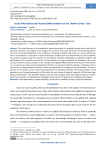
Social Polarization and Income Differentiation on the “North-Center” Axis
Статья научная
The article focuses on the problem of social polarization in the global context and on the level of particular countries. The subject of the study is the economic and social parameters of functioning mechanisms of territorial development in the conditions of existing instability and social risk. Income differentiation is considered as a key factor of social distancing of society and as a determinant of social instability. The authors compare data from reports of international economic organizations, statistical bulletins and publications of the scientific community. The proportions of income inequality are analyzed in the cross-country and intra-country contexts; as an example, the regional differentiation of the Russian Arctic territories, as well as the urban and rural population of China, are assessed. Dynamic changes in absolute and relative terms of living standard indicators confirm the hypothesis of increasing social polarization. The development of the Russian Arctic territories demonstrates an imbalance between the living standards of the population and the perceived quality of life, while the main trends of regional inequality in China have clear group characteristics. The identified patterns can be used to adjust social and regional policies, to determine the parameters of development strategies and the content of government programs and projects.
Бесплатно
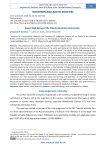
Social Well-Being of the Yakutia Business Community
Статья научная
The purpose of this article was to study the modern regional labor market under the influence of major challenges and to identify the features of the social well-being of the Yakutia entrepreneurial community against the backdrop of coronavirus infection in the Arctic. The results of our study showed that the coronavirus crisis has affected all areas of entrepreneurial activity, but with different territorial projections. COVID-19 had a particularly negative impact on the economy as a whole, employment and household budgets in large settlements of Yakutia, where the solvent population, service/paid services and those employed in them are concentrated, as well as on the remote but promising Arctic zone of the region. Despite the noticeable differentiation of the zonal, status level and quality of life of the population of the republic, according to the results of our survey, the positive assessment of the personal prospects of respondents from the general array of the surveyed population in the Republic of Sakha (Yakutia) and among entrepreneurs of the Arctic zone is quite comparable: 63.3% and 62.7%, respectively. Urban entrepreneurs work in more comfortable conditions (comprehensive infrastructure support, more efficient access to information, convenient logistics for receiving goods, a more extensive customer base for doing business, etc.). Rural entrepreneurs are more focused on a collective spirit, hard-working and optimistic. An important factor determining the social well-being of entrepreneurs is economic and legal mechanisms, which include issues of infrastructure support for small and medium-sized businesses, effective interaction with government authorities, targeted regional development programs and personal adaptation strategies.
Бесплатно
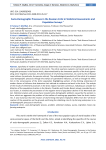
Socio-Demographic Processes in the Russian Arctic in Statistical Assessments and Population Surveys
Статья научная
Specificity of modern social processes determines close attention of the global scientific community to socio-demographic processes in the Arctic. The article examines systemic and recent social and demographic processes in the Russian Arctic, determined both by the immanent specifics of the Arctic (generating active migration processes, the phenomenon of city-forming enterprises, etc.) and by the all-Russian social reforms (in particular, the pension reform). The methodological peculiarity of the article is to present socio-demographic processes through the analysis of quantitative indicators, as well as through the reflection in the consciousness of the Arctic population (highlighting workers of city-forming enterprises) of modern factors of influence that determine their attitude to residence and work in the Arctic. The analysis of the results of settlement processes in the Arctic regions has been carried out, indicating an unstable stabilization of the population situation in the Nenets, Chukotka and Yamalo-Nenets okrugs, provided by various factors; it revealed the preservation of the negative trend of population decline in the Murmansk Oblast. Statistical analysis and surveys have revealed socio-demographic problems caused by the pension reform, which can aggravate the problem of the outflow of working-age population from the Arctic territories. It was found out that the reaction of city-forming enterprise employees differs from the "all-Arctic" reaction of the population on the grounds confirming the stabilizing role of city-forming enterprises in socio-demographic processes in the Arctic.
Бесплатно

